AMD Announces Ryzen Threadripper Pro 5000 WX-Series: Zen 3 For OEM Workstations
by Gavin Bonshor on March 8, 2022 9:00 AM EST
In 2020, AMD released a new series of workstation-focused processors under its Threadripper umbrella, aptly named the Threadripper Pro series. These chips were essentially true workstation versions of AMD's EPYC server processors, offering the same massive core counts and high memory bandwidth as AMD's high-performance server platform. By introducing Threadripper Pro, AMD carved out an explicit processor family for high-performance workstations, a task that was previously awkwardly juggled by the older Threadripper and EPYC processors.
Now, just under two years since the release of the original Threadripper 3000 Pro series, AMD is upgrading that lineup with the announcement of the new Threadripper Pro 5000 series. Based on AMD's Zen 3 architecture, the newest Threadripper Pro chips are designed to up the ante once more in terms of performance, taking advantage of Zen 3's higher IPC as well as higher clockspeeds. Altogether AMD is releasing five new SKUs, ranging from 12c/24t to 64c/128t, which combined with support for 8 channels of DDR4 across the entire lineup, will offer a mix of chips for both CPU-hungry and bandwidth-hungry compute tasks.
AMD Ryzen Threadripper Pro 5000 WX-Series: What's New?
Like the previous generation of TR 3000 Pro WX processors, the TR 5000 Pro WX series bridges the gap between AMD's modern desktop Ryzen range and its EPYC 7003 processors, offering powerful configurations like the EPYC, but in a chip/platform better suited for use in workstations. The biggest draw of the TR 5000 Pro WX is of course the large number of CPU cores – up to 64 of them in a single chip – but memory bandwidth is also a major factor, as the TR 5000 Pro WX series gets 8 channels of DDR4. Overall this is identical to high-end EPYC chips, or four times as many cores and memory channels as a top-end Ryzen chip.
With 8 memory channels, the TR 5000 Pro can support up to 2TB of DDR4-3200 DRAM – with ECC support included, of course. TR 5000 Pro is solely a single socket platform (LGA 4094), so dual socket EPYC setups do have a slight edge in total memory capacity since they can amass 2TB per chip. In fact, total platform memory capacity remains one of the few notable feature differentiators between TR Pro and EPYC, as AMD intends for its server processor to be at the top of its stack.
As a result, AMD's current crop of product families looks like the following:
- AMD Ryzen = Desktop
- AMD Threadripper = HEDT (& MIA)
- AMD Threadripper Pro WX = Workstation
- AMD EPYC = Server
Coming from the last-generation Threadripper Pro 3000 platform, the most significant change within the Ryzen TR 5000 Pro series is that its cores are now based on AMD's highly successful and performance-focused Zen 3 architecture, replacing the older Zen 2 cores used in the original TR Pro 3000. As with the EPYC processors these parts are derived from, AMD is using a combination of Zen 3 chiplets (CCDs) built on TSMC's 7nm process, as well as its familiar I/O die which is built on Global Foundries' 12 nm process.
Updating Threadripper Pro to use the Zen 3 architecture yields multiple benefits, including a notable improvement in IPC and frequency as compared to its previous Zen 2 microarchitecture. In the case of clockspeeds, turbo frequencies have been increased across the entire stack to 4.5 GHz, a 200 MHz increase over the previous TR 3000 Pro chips.
In line with its latest Zen 3 based EPYC 7003 processors for the server market, TR 5000 Pro WX also includes AMD's hardware-level Shadow Stack security. AMD Shadow Stack is designed to negate control-flow attacks, with additional hardware-level support from Microsoft Hardware-enforced stack protection which forms one of AMD's Shadow Stacks key securities. AMD's security stack is multi-layered, with support for OEM-enabled security features at the top, while Shadow Stack sits among the core complex for stringent cryptographic security.
AMD Ryzen Threadripper Pro 5000 WX-Series For Workstations: The Stack
In total, AMD plans to include five different TR 5000 Pro SKUs. This consists of the top chip, the TR Pro 5995WX, which consists of 64 cores/128 threads. This chip has a base frequency of 2.7 GHz and can turbo up to 4.5 GHz across the entirety of its cores.
| AMD Ryzen Threadripper 5000 Pro (Zen 3 "Chagall") | ||||||||
| AnandTech | Cores | Base Freq |
Turbo Freq |
PCIe (Gen 4) |
Chiplet (CCD/IO) |
Cache (L3) |
TDP | DRAM |
| 5995WX | 64 / 128 | 2700 | 4500 | 128 | 8+1 | 256 MB | 280 W | 8 x DDR4-3200 |
| 5975WX | 32 / 64 | 3600 | 4500 | 128 | 4+1 | 128 MB | 280 W | 8 x DDR4-3200 |
| 5965WX | 24 / 48 | 3800 | 4500 | 128 | 4+1 | 128 MB | 280 W | 8 x DDR4-3200 |
| 5955WX | 16 / 32 | 4000 | 4500 | 128 | 2+1 | 64 MB | 280 W | 8 x DDR4-3200 |
| 5945WX | 12 / 24 | 4100 | 4500 | 128 | 2+1 | 64 MB |
280 W | 8 x DDR4-3200 |
Moving down the stack is the TR Pro 5975WX, with 32 cores/64 threads and a base core frequency of 3.6 GHz. Further down is perhaps one of the most interesting inclusions, the TR Pro 5965WX, which has 24 cores/48 threads and bridges the gap between the 32-core/64-thread TR Pro 5975WX, and the 16-core/32-thread TR Pro 5955WX. The addition of the TR Pro 5965WX is something many users have been asking for, as it offers a more direct competitive angle against Intel's 24-core Xeon workstation-focused processor, the Intel Xeon W-3345.
And for users who need the TR Pro platform's memory bandwidth more than they need the cores, AMD also has a 12-core variant, the TR Pro 5945WX. This chip has a base core frequency of 4.1 GHz, and more importantly the same 8-channels of DDR4-3200 memory as the other TR Pro chips.
All of the new TR 5000 Pro chips also benefit from a reorganized L3 cache. Compared to the last generation TR 3000 Pro chips, AMD has increased the multi-core L3 cache cluster from 4-core x 16 MB to a larger 8-core x 32 MB cluster. It's worth pointing out that each CCD has 64 MB of cache associated with it, so the TR Pro 5995WX has 256 GB, whereas the lower 12-core 5945WX has just 64 MB of L3 cache available to it.
AMD has also expanded PCIe support on its TR 5000 Pro processors to 128 x PCIe 4.0 lanes, up from 120 x PCIe 4.0 lanes on the TR 3000 Pro. It should be noted that AMD hasn't specified whether or not the additional 8 x PCIe 4.0 lanes are embedded on the I/O die of the processor itself, or this comes from the chipset.
Finally, AMD has confirmed to us that the new TR 5000 Pro chips will use the same WRX80 platform as the previous generation. So along with reusing the existing sWRX8 socket, existing WRX80 motherboards will only need a firmware update to be compatible with the new chips.
AMD Ryzen Threadripper Pro 5000 WX-Series: OEM Only
It should be noted that these new processors will be OEM-only, at least for now. This means that anyone looking to leverage AMD's Ryzen Threadripper Pro 5000 WX-series processors will need to turn to Lenovo (or eventually, other applicable vendors) to obtain a complete system.
While AMD and vendors did eventually open up pathways for other system integrators via AMD WRX80 motherboards to utilize TR 3000 Pro, it remains unclear whether AMD will go the same route with TR 5000 Pro processors. For now, Lenovo is once again AMD's key launch partner, and to that end Lenovo is releasing an updated version of the ThinkStation P620 to coincide with today's announcement.
While we don't have a full list of specifications of the latest ThinkStation P620, we know it will offer an 8-memory slot motherboard to capitalize on the 8-channel memory bandwidth, which is undoubtedly one of the most prominent features of the WRX80 platform. Judging from the design of the TR 3000 Pro version, it will likely have a transposed socket to allow Lenovo to fit a large cooler better suited to supporting the 280 W TDP. At the same time, it should also offer customizability, albeit what options users can alter remains unclear.
Finally, it's worth noting that AMD isn't offering any pricing guidance here. Since TR 5000 Pro is OEM-only – and thus, you can't buy a chip directly from AMD ot its distributors – AMD has little need to publish pricing information. Instead, pricing will be up to the OEMs, who will be designing and pricing their workstations as they see fit.
Competition in the Workstation Space: AMD Versus Intel
In the workstation segment of the market, AMD's biggest competitor for the moment is Intel's W-3300 series of processors. Intel launched its Xeon W-3300 family back in July 2021, which is its third generation of workstation-focused Xeon products. Intel Xeon W-3300 is based on Intel's Ice Lake scalable platform, which is built on their original 10nm manufacturing process.
However, the dynamic of AMD's competition will change slightly when Intel launches its highly anticipated Sapphire Rapids Xeon Scalable platform, built upon the Intel 7 manufacturing process. Like its Alder Lake processors for desktop, Sapphire Rapids will feature the Golden Cove core architecture across its cores. Another significant change for Sapphire Rapids is that Intel uses on-package HBM2E, which adds "graphics-like" memory bandwidth (roughly x4) directly to the CPU workloads.
Focusing on the now and not the future, AMD has published a set of in-house attained performance data, something both Intel and AMD do surrounding their product launches. Comparing the top SKU from AMD, the TR 5995 WX, to Intel's current flagship workstation processor, the Xeon W-3375, AMD believes they have a distinct advantage in both core/thread count, PCIe lanes, L3 Cache, and core frequency. The key differences between both the flagship workstation processors from AMD and Intel are noted below:
- TR Pro 5995 WX has 26 more cores and 52 more threads than the Xeon W-3375 (68% more)
- TR Pro 5995 WX has roughly 350% more L3 cache (256 MB versus 57 MB)
- TR Pro 5995 WX has 100% more PCIe lanes than the Xeon W-3375 (128 versus 64)
Based on its in-house testing comparing each TR Pro 5000 processor to the aligned Intel Xeon W-3300 series processor, AMD is claiming multiple wins in performance. This includes up to 40% faster performance in Unreal Engine performance, which is a highly multi-threaded workload – although this is expected given the TR Pro 5995 WX has 40% more cores/threads than the Xeon W-3375.
Focusing on the comparisons with equal core and thread counts such as the TR Pro 5975X to the Xeon W-3365, which both feature 32-cores and 64-threads, AMD is claiming up to 32% better performance in Unreal Engine, as well as up to 55% extra performance in Adobe After Effects.
Across the board, AMD is claiming between 25% and 42% better performance on its 12-core and 16-core comparisons across Unreal Engine, After Effects, and in Chaos V-Ray performance, which is a notable jump in performance if the real-world performance improvements match.
Moving back to AMD's flagship TR Pro 5995 WX processor for workstations, AMD claims more wins than directly against 2 x Intel Xeon Platinum 8280 server processors. This means that the figures in the above slide were achieved using a 64-core/128-thread TR Pro 5995 WX processor against 2 x Xeon Platinum 8280 processors with a combined total of 56-cores and 112-threads.
AMD states in the small print that it is comparing all of its figures against 'similarly configured' BOXX APEXX4 workstations. Still, unfortunately, AMD doesn't list the specifications or configurations of these systems.
Summary
AMD is launching its Ryzen Threadripper 5000 Pro series with Lenovo via the ThinkStation P620 workstations. This is similar to its launch of the previous TR 3000 Pro processors. At the time of writing, AMD hasn't provided information as to when we can expect TR 5000 Pro WX to hit the market or when the latest Lenovo ThinkStation P620 workstation will be launched or announced.
On AMD's performance claims, it looks as though TR 5000 Pro will further improve upon its current grasp on leading-edge workstation solutions, especially with the generational increase that Zen 3 brings in overall IPC performance when compared to Zen 2 (TR 3000 Pro).
It remains to be seen how the emerging battle in the workstation segment of the market will intensify as Intel rolls out Sapphire Rapids-SP processors with Intel's EMIB interconnect and HBM2e memory. These chips are expected to be released sometime in 2022, but it's noted that Sapphire Rapids has already been delayed before, as they were previously expected in Q2 2022.
The key focus of today's announcement is that systems based on AMD's Ryzen Threadripper Pro 5000 WX-series processors will be available to purchase from March 21st, with Lenovo and the ThinkStation P620 workstation being the release platform of choice. AMD did inform us that they expect to have more partners on board in the second half of 2022, which implies a similar ramp-up to what we saw with the previous generation of Threadripper Pro.


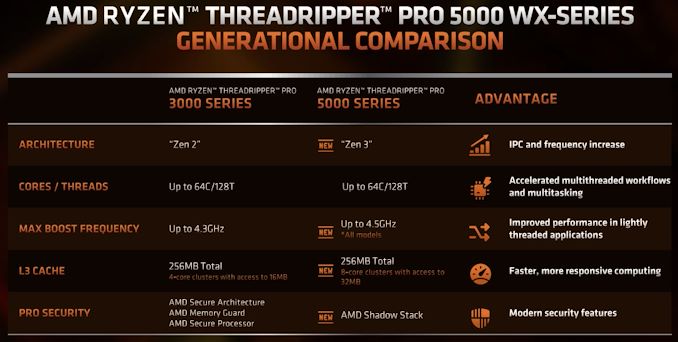
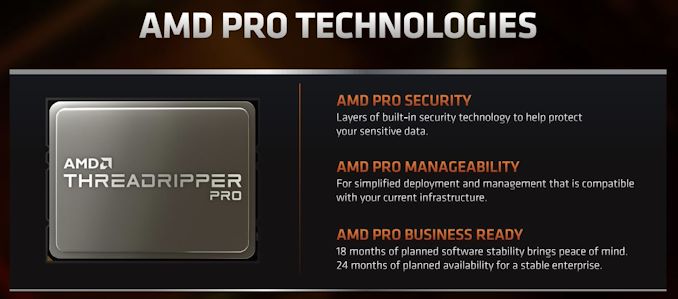

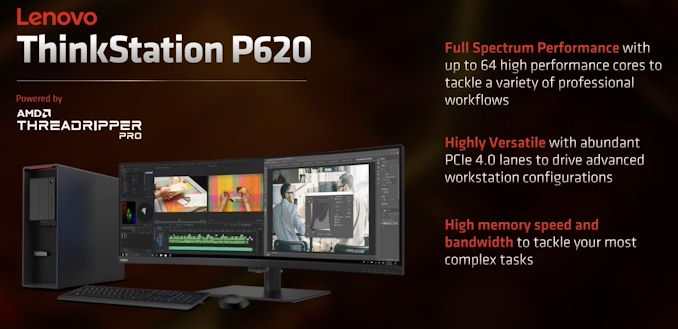
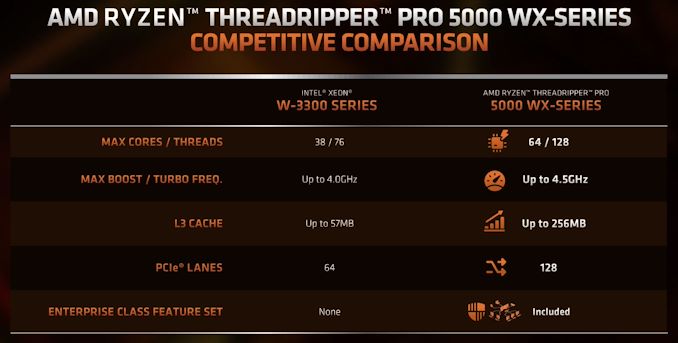
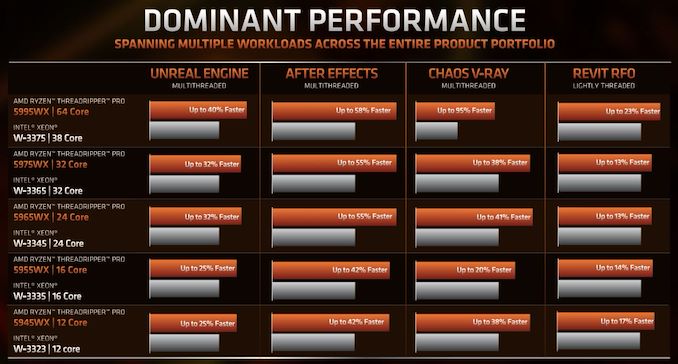
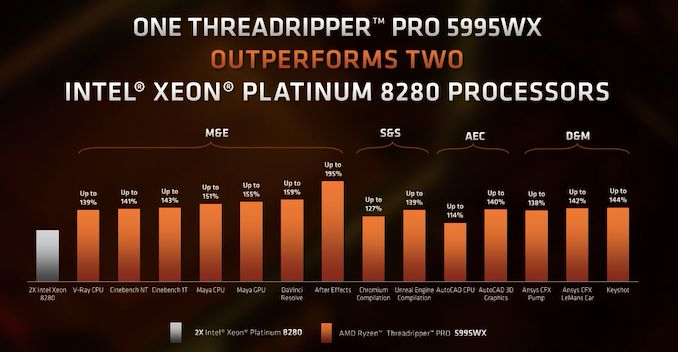








34 Comments
View All Comments
Blastdoor - Tuesday, March 8, 2022 - link
AMD wasn't just resting on their laurels -- they were completely passed out after going on a weekend bender celebrating their total triumph over Intel in the HEDT/workstation market.Nice to see them finally waking up, but if they are going to wait another 2 years before releasing a Zen 4 TR then Intel is going to take back the workstation market.
AshlayW - Tuesday, March 8, 2022 - link
Yeah - I'm a lot more interested in this potential Sapphire Rapids-X HEDT lineup Intel apparently has in the works, I'm almost positively foaming at the mouth at the idea of 4 or even 6, 8 channel (as in, DIMMs, not the sub channels) DDR5.CBeddoe - Tuesday, March 8, 2022 - link
To me there isn't much comparison between Threadripper Pro to Intel Xeon solutions for workstations. I'd take Threadripper every day.Intel costs 2-3x more for no reason.
Not sure what sapphire rapids is going to bring but it's going to have to be really good and pretty reasonable.
WaltC - Tuesday, March 8, 2022 - link
Agreed, of course. This was a great write up by Ian! I can't quite recall what Intel's upcoming "process 7" is on the nm scale--a combination of 7nm + 10 nm, I seem to recall--since Intel isn't using the nm scale as AMD uses. I think that AMD has quite a few tricks to pull out of its hat this year. Should be an exciting year for both companies, if both of them are able to execute on their announced production goals.kwohlt - Tuesday, March 8, 2022 - link
What do you mean the nm scale? You don't actually think TSMC's 7nm literally measures 7nm in size, do you?JayNor - Tuesday, March 8, 2022 - link
Did Ian contribute?ct909 - Monday, April 11, 2022 - link
For a single-CPU workstation, I'm not sure Intel are pushing the Xeon barrow any more - now that ECC is available using the Core CPU + W series chipset based M/Board.mode_13h - Tuesday, March 8, 2022 - link
> they were completely passed outNot sure about that. It's true they had little competitive pressure on the workstation front, but also very strong demand for a limited supply of Zen 3 dies in the server and desktop markets. So, it's not hard to see why this took so long.
I agree that they won't be able to afford such a long delay for the Zen 4 Threadripper, but hopefully the supply crunch for semiconductors won't be as bad then, either.
StevoLincolnite - Tuesday, March 8, 2022 - link
AMD wasn't resting on their laurels.There was a chip shortage... And AMD was using all their chips for servers rather than HEDT/Workstations... Which is actually more profitable.
Oxford Guy - Thursday, March 17, 2022 - link
And ‘consoles’ and 6500 XTs.